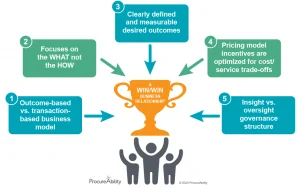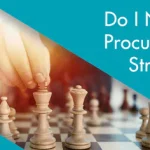
When negotiating outsourcing arrangements, buyers, often led by procurement, have historically focused on their organization’s needs, even at the expense of the seller. This win-lose strategy can create adversarial relationships between buyers and sellers (service providers, in this case) and damage the relationship before it even starts. Vested Outsourcing, a business model pioneered by companies as diverse as McDonald’s and Microsoft, offers an alternative to the win-lose negotiation model and focuses on shared values and goals to create an outsourcing relationship that is mutually beneficial.[1] This article will cover the five rules of Vested Outsourcing to help your procurement organization transform how it views outsourcing.
- Outcome-based vs. transaction-based business model
- Focuses on the what not the how
- Clearly defined and measurable desired outcomes
- Pricing model incentives are optimized for cost/service trade-offs
- Insight vs. oversight governance structure
- Outcome-based vs. Transaction-based Business Model
In a transaction-based approach, outsourcing buyers typically use a competitive bid with a price-per-transaction and a goal to obtain the lowest cost per transaction. Meanwhile the service provider will be compensated on each transaction, leaving little incentive for the provider to drive efficiency to reduce transaction volume. The Vested Outsourcing model utilizes an outcome-based approach that seeks to create alignment between the outsourcing buyer and service provider.
This alignment is formed by moving away from the traditional, transactional unit-pricing model, and towards an executional approach. First, both parties come to the table with desired outcomes that are able to be quantified. A few examples of these quantifiable outcomes are reliability, sustainability, cost, etc. The main objective is for the outsourcing buyer to purchase their desired outcomes and for the service provider to maximize their profit by providing the buyer with the highest completion of desired outcomes.
- Focus on the What not the How
The Vested Outsourcing approach does not replace or minimize the underlying need for work that must get done. Vested Outsourcing further reinforces the need to outsource processes that are ripe for improvement and would benefit from being delivered by service providers who specialize in those areas. As an outsourcing buyer, the focus should be on the work being delivered and not on how the service provider delivers these results.
- Clearly Defined and Measurable Outcomes
The Vested Outsourcing model doesn’t work if all parties involved do not specifically vocalize their desired outcomes. To be successful, these outcomes should be limited to five (5) metrics that can be quantified to measure performance. By capturing the desired outcomes during both the initial planning process of the outsourcing as well as in the contract negotiation phase, both parties will be less likely to spend excess resources focusing on the wrong metrics. By setting up the outsourcing process in this way, the outsourcing buyer anchors the service provider to a particular price, that will only be paid if the provider matches the negotiated performance level.
- Optimize Pricing Model Incentives for Cost/Service Trade-offs
In addition to defining clear and measurable outcomes, a successful Vested Outsourcing event requires a pricing model that balances a cost-for-service trade-off. When establishing the pricing model, businesses should apply two principles:
- The pricing model must balance risk and reward for the organizations.
- The agreement should specify that the service provider will deliver solutions, not just activities.[2]
Ultimately, the Vested Outsourcing framework allows the outsourcing buyer to reach their desired outcomes, while simultaneously incentivizing the service provider to perform at a higher level than they otherwise would in a transaction-based model.
- Insight vs. Oversight Governance Structure
To conduct a successful Vested Outsourcing partnership, the outsourcing buyer must do their due diligence in designing the correct performance metrics and agreements. If the business manages the planning process successfully, then they will in turn choose the correct service provider to manage the work and will ultimately require less oversight and generate greater insight.
Whatever the size of your procurement organization, if you are outsourcing services then there is something to be gained by exploring the Vested Outsourcing model.
Note: This blog was inspired by, “Vested Outsourcing: Five Rules That Will Transform Outsourcing” by Kate Vitasek, Karl B. Mandrodt and Mike Ledyard
Citations:
[1] Vitasek, Kate; Ledyard, Mike; Manrodt, Karl (2010). Vested Outsourcing, Second Edition: Five Rules That Will Transform Outsourcing. New York, NY: Palgrave MacMillan. ISBN 978-1-137-29719-8.
[2] Vitasek, Kate. “Vested Outsourcing: Game-Changing Rules for Outsourcing.” IndustryWeek, 29 Sept. 2010.
Subscribe to Arroyo Strategy Insights to access whitepapers, presentations, plus our latest thought leadership.



